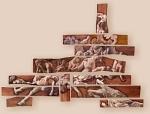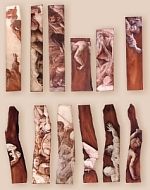 |
 |
Views
of the Image and
Likeness Installation
at the Caracas Museum
of Contemporary Art |
|
 |
(1)
Raft of the Medusa, after Gericault
(Group of horizontal panels)
zoom |
|
 |
(2)
Raft of the Medusa, after Gericault
(Group of vertical panels)
zoom |
|
 |
(3)
Raft of the the Medusa, after Gericault
(Group of random panels)
zoom |
|
 |
(4)
Raft of the Medusa, after Gericault
zoom |
|
 |
(5)
Christ in the Sepulcher,
after Holbein
zoom |
For the last few years, Paco
Bugallo has devoted himself to the creation of a vast pictorial installation based on
Gericault’s Raft of Medusa, a paradigmatic work of 19th century romanticism. This
gigantic and overwhelming canvas surpasses the terrible episode of the shipwreck and the
concealed intention of reporting corruption in the French government of the time for
allowing an inexperienced sailor to guide the ship. Even when the circumstances and the
details are forgotten, as well as the scandal, this work keeps all its expressive force,
its dramatic dimension, since there is only tragedy left, tragedy in its pure state,
without time or place, humankind’s struggle for survival, their desperation and hope,
Thanatos and Eros.
Gericault is one of those artists
that take other paintings as a reference. We can say, just for the record, that he used to
go to the morgue to study the corpses of drowned men, or that he made in his workshop a
setting for his future painting (he had a raft made and asked his friends to pose as
models in the positions he wanted). Apart from the realism achieved, we find in this
painting, and in its atmosphere, the culture of painting: the bodies inspired by
Michelangelo, the baroque movement of the composition, the wish to grant a profane scene,
a terrible event with a total lack of heroism, the dignity and the nobility of great
religious art. Gericault is heir to the painting of the past, he gives new meanings to old
forms, and thus he gives new life to them at the same time as he makes them perpetual. In
this sense there are great similarities between Gericault and Bugallo, and between them
and all the artists that approach themselves to painting through painting itself (more
than through nature), and that save images from the archives and hand them to the present
and sometimes to posterity.
Here, it is striking that Bugallo
transforms into an installation a painting that, before it was a painting, was an
"installation" avant la lettre in Gericault’s shop. And although it may
seem a bit farfetched, because of the differences in their style and their intentions, we
could compare Bugallo’s "Raft" with a crude and hyper-realistic
reproduction of Gericault’s painting, three-dimensional and containing waxworks, that
is found in the Musée Grévin in Paris. In the latter, since only the topic was kept and
that thing added to reality, that is, art, has disappeared, the horrific side of the event
is what stands out, just as it would appear in a tabloid. On the other hand, in
Bugallo’s plastic reinterpretation this aspect has been eliminated from the painting,
where all the circumstantial elements have been erased and substituted by the contrast
between the black shapes and the green background, re-taking abstract painting. It is not
about some shipwrecked people from the Medusa, but about humanity looking for its destiny.
And at the same time, the gist of Bugallo’s work is formulated again, that effort to
define the added reality. Through these two different versions of Gericault’s
painting there has been a split between its anecdotal and its existential aspect, its
documentary side and its artistic side. Bugallo is only interested in the existential and
the artistic. And suffering cannot be absent: it is embodied in the hurtful fragmentation
of the bodies on the wooden boards, boards that reminds us of those of a raft.
Gericault had developed a profane theme from the archetypal foundations
of religious painting tradition. Now Bugallo gives the humanism of Gericault’s work
an aura of spirituality. Just as he takes some wooden board out of a dead tree to
celebrate art’s life, he makes of his installation a sort of diptych between
desperation and hope. Behind the version of The Raft of the Medusa, where he has
eliminated the brig that the rafters glimpsed as the symbol of their salvation, he puts an
interpretation of Holbein’s Dead Christ, going from the detail to the general. The
metaphor seems clear: Christ is the true salvation. However, it is a Christ that has not
resurrected yet, an inaccessible figure in its Byzantine golden halo, a piece of painted
wood in the end. The light of hope is also surrounded by the shadows of doubt.
Federica Palomero
June 1999
(From the exhibition catalog) |

